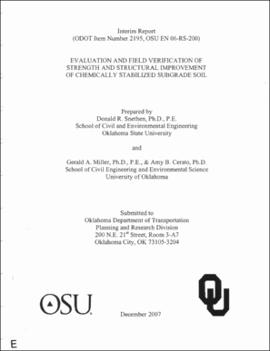| dc.description.abstract | Often subgrade soils exhibit properties, particularly strength and/or volume change properties that limit their performance as a support element for pavements. Typical problems include shrink-swell, settlement, collapse, erosion or simply insufficient strength. A common approach to subgrade soil support or stability problems involves chemical modification or stabilization with additives such as lime (hydrated or quick), fly ash (Class C from lignite coal), cement kiln dust (CKD) or Portland cement. Other additives· are available, but this group constitutes the major products or by-products used on roadway construction in Oklahoma. The type and amount of chemical additive is dependent on the purpose or function of the treated material (i.e., improved physical properties or improved strength) and selection is based on aceepted or standardized procedures. Questions then arise with regard to chemically treated subgrade soils about the rate of development and ultimate value of improvement. The purpose of this research is to develop relationships between rate of development and magnitude of strength (or physical property) improvement for chemically treated subgrade soils. The purpose of this interim report is to summarize the results of recent research into any existing relationships and current experience with chemically treated soils as used in the AASHTO-MEPDG. No active or recently completed research involved with characterizing Level 2 and 3 design input parameters for AASHTO-MEPDG was found. The closest research topics involved the use of field and laboratory data to calculate structural layer coefficients. The research confirmed that when chemically treated subgrade soil layers were included in the structural design of the pavement, the layer coefficients were conservative and the resulting pavement layer thicknesses were reduced, as was the construction cost. Most of the recent research evaluation of performance of various chemical additives. Most of the evaluations were between different chemicals, i.e. lime vs. fly ash vs. CKD, etc. The research reaffirmed that chemicals such as lime, fly ash, CKD, and cement generally perform well in most fine-grained soils as long as the type and amount of the chemical are selected to meet the purpose of the treated layer and problem soils are identified and considered in the selection process. | |
